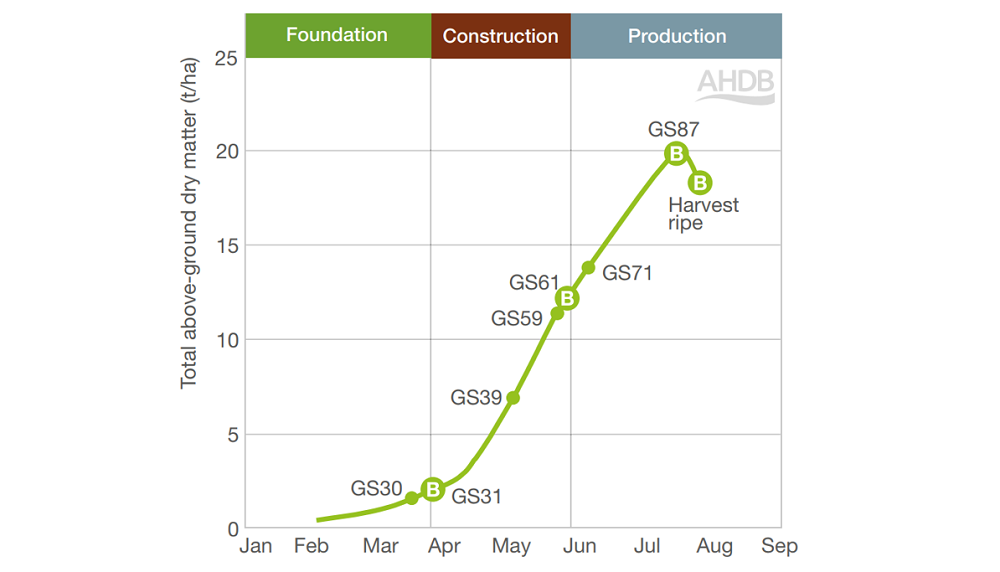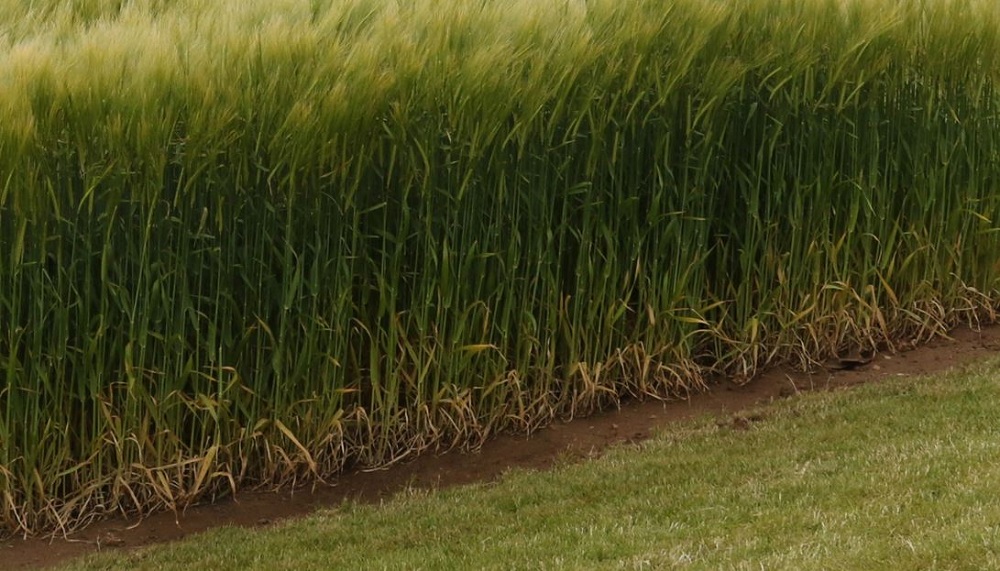- Home
- Knowledge library
- Biomass growth and dry matter accumulation in wheat
Biomass growth and dry matter accumulation in wheat
Biomass growth represents the net effect of photosynthesis, after losses from respiration and leaf fall. It can be assessed by measuring changes in above-ground dry matter over time.
Growth guides for wheat, barley and oilseed rape
How to measure dry matter in cereals
Key facts about wheat growth
- Most (90%) of final crop dry matter is formed after GS31
- Winter wheat grows by 0.18 t/ha/day (1.3 t/ha/week) from May to July
- Crop growth on dull days is less than half that on bright days
- Grain dry matter accumulates during the production (50–80%) and construction (20–50%) phases

Growth during the foundation phase
Benchmark: 1.9 t/ha above-ground growth by GS31 (10 April)
Varietal influence: High
Other influences: N supply, shoot number
Growth is slow over winter, as canopy cover is incomplete and sunlight is limited. In fact, just 10% of total growth occurs by GS31 (six months after sowing). Dry matter formed in the initial period produces leaves that are all lost before flowering, with only their N redistributed in the plant.
Growth during the construction phase
Benchmark: 10.2 t/ha increase in above-ground growth from GS31 to GS61
Varietal influence: High
Other influences: N supply, shoot number
Rapid growth starts in late April, as internodes start to extend and light interception approaches 100% as sunlight intensity increases. Over half of total growth occurs in this phase. Dry matter produced in this period supports at least 0.6 t/ha extra root growth and the formation of all the organs vital to grain production.
Stem reserves act as a buffer and accumulate when photosynthetic rate is adequate and fall when photosynthesis is inadequate (e.g. on dull days).
Each fertile stem has a finite storage capacity for grain dry matter, determined by fertile floret numbers. The amount stored depends on how much dry matter is partitioned to the ear during booting and ear emergence. Partitioning differs between varieties.
Growth may slow towards the end of crop construction, if storage capacity is already full.
Rapid growth (Late April to July)
Benchmark: 0.18t/ha/day from May to July
Varietal influence: High
Other influences: Water, light, canopy size
Rapid growth arises from complete interception of intense sunlight. Slow growth results from incomplete light interception or dull conditions.
Respiration reduces dry matter, particularly when tissues are senescing. Respiration rate is increased by temperature and continues during the night, so high night-time temperatures result in increased reductions in dry matter.
Growth during the production phase
Benchmark: 7.5 t/ha increase in above-ground growth from GS61–87, then 1.2 t/ha loss to harvest
Varietal influence: High
Other influences: N supply, disease
Rapid growth continues, although it slows slightly as leaves age and larger organs respire more in warmer weather. Soil water may also become limiting.
Only grains accumulate dry matter after flowering. Other plant parts (e.g. stems and leaves) lose weight, although chaff remains constant. As most soluble stem reserves produced pre-flowering are redistributed, grain growth always exceeds total crop growth during this phase.
Canopy senescence occurs as leaf and stem N moves to the grain. Thus, as grain proteins form, photosynthesis progressively slows. Senescence can be delayed if N and water uptake continue.
Rapid grain filling starts at GS71 and ends at about GS87, even if green tissues remain. Early canopy senescence, often due to drought or disease, brings grain filling to a premature end.
Crop dry weight often decreases from its maximum, mainly owing to ongoing respiration, but also through leaf loss. Dry matter is rarely lost from grain.
Natural resource capture and conversion by cereal crops
Discover how wheat and barley capture and convert natural resources (solar energy, carbon dioxide and water) into edible (e.g. grain) and other forms of biomass/energy.


